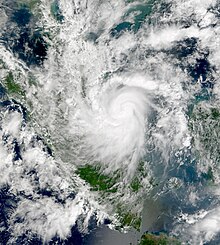List of tropical cyclones near the Equator
Typically, tropical cyclones form at least 5.0 degrees of latitude north and south of the equator, or at least 300 nautical miles (556 km, 345 mi) of the equator. Despite the presence of sufficiently warm sea surface temperatures and generally low wind shear, tropical cyclogenesis is uncommon at these latitudes, due to a lack of the Coriolis force, which causes cyclones to spin. On rare occasions, tropical cyclones can develop within 5º of the equator, though it is more prevalent in the northwestern Pacific Ocean.

Background
editFor centuries, sailors haven't worried about tropical storms near the equator. It's a rule that cyclones are not supposed to develop there.
Dr. Chih-Pei Chang, professor at the United States Naval Research Laboratory[1]
Various factors converge to produce a tropical cyclone, including sufficiently warm sea surface temperatures, low wind shear, ample moisture, and enough atmospheric instability to produce thunderstorms. In addition, weather disturbances typically need to be far enough away from the equator to spin, known as vorticity. This is due to increasing Coriolis force closer to the poles, and which is zero at the equator.[2][3][4] One associated phenomenon often seen with low-latitude cyclones is the equatorial westerly wind burst, which allows for sufficient shear vorticity on both sides of the equator to support tropical cyclogenesis.[5] Westerly wind bursts are typically the most common in the equatorial Western Pacific Ocean.[6]
List
editNote: Only systems that were of tropical depression strength or higher within 5.0 degrees of the equator are included.
See also
editReferences
edit- ^ "Breaking the Typhoon Rules". Jet Propultion Laboratory. Retrieved March 31, 2024.
- ^ "Tropical Cyclone Introduction". National Oceanic and Atmospheric Administration. September 8, 2023. Retrieved March 31, 2024.
- ^ "Tropical Cyclone Introduction". National Weather Service. Retrieved 23 April 2023.
- ^ Chun-yuen, Chau. "Why do Tropical Cyclones always Form more than 5 degrees of Latitude away from the Equator?". Hong Kong Observatory. Retrieved 23 April 2023.
- ^ "Linkage Between Westerly Wind Bursts and Tropical Cyclones". American Geophysical Union. October 10, 2018. Retrieved May 21, 2024.
- ^ "Generation of westerly wind bursts by forcing outside the tropics". Nature.com. January 13, 2021. Retrieved May 21, 2024.
- ^ "2001 VAMEI (2001361N01106)". The International Best Track Archive for Climate Stewardship (IBTrACS). Retrieved 19 May 2017.
- ^ Report on Cyclonic Disturbances Over North Indian Ocean During 2004 (PDF) (Report). India Meteorological Department. January 2005. Retrieved 2015-05-24.
- ^ "1956 01W:SARAH (1956081N02154)". The International Best Track Archive for Climate Stewardship (IBTrACS). Retrieved 19 May 2017.
- ^ "1979 ALICE (1978361N02180)". The International Best Track Archive for Climate Stewardship (IBTrACS). Retrieved 19 May 2017.
- ^ "2014 PEIPAH (2014093N02148)". The International Best Track Archive for Climate Stewardship (IBTrACS). Retrieved 19 May 2017.
- ^ "WWJP27 RJTD 040600". Japan Meteorological Agency. 4 March 2023. Archived from the original on 4 March 2023. Retrieved 4 March 2023.
- ^ "TROPICAL CYCLONE REPORT - TROPICAL DEPRESSION NINE-C" (PDF). Central Pacific Hurricane Center. 22 December 2016. Archived from the original (PDF) on 25 March 2024. Retrieved 25 March 2024.
- ^ "1977 PATSY (1977082N03165)". The International Best Track Archive for Climate Stewardship (IBTrACS). Retrieved 19 May 2017.
- ^ "2002 Moderate Tropical Storm Abaimba (2002247S03067)". International Best Track Archive for Climate Stewardship. Retrieved April 2, 2024.
- ^ "TROPICAL CYCLONE REPORT - HURRICANE PALI" (PDF). Central Pacific Hurricane Center. 13 December 2018. Archived from the original (PDF) on 26 January 2019. Retrieved 26 January 2019.
- ^ "Extremely Severe Cyclonic Storm "FANI" over eastcentral equatorial Indian Ocean and adjoining southeast Bay of Bengal (26 April – 04 May, 2019): Summary" (PDF). India Meteorological Department. Retrieved May 17, 2024.
- ^ "Best Track Data on Very Intense Tropical Cyclone Fabien (10)". Météo-France. Retrieved 25 March 2024.
- ^ "1959 HARRIET (1959356N05152)". The International Best Track Archive for Climate Stewardship (IBTrACS). Retrieved 19 May 2017.
- ^ "CYCLONE AND CYCLONIC ACTIVITY LA REUNION". 22 May 2024. Archived from the original on 22 May 2024.
- ^ Annual Report on the Activities of the RSMC Tokyo - Typhoon Center 2012 (PDF) (Report). Japan Meteorological Agency. Retrieved April 2, 2024.
- ^ WMO / ESCAP Panel on Tropical Cyclones Annual Review 2002 (PDF) (Report). World Meteorological Organization. Retrieved April 2, 2024.
- ^ "1970 Super Typhoon Kate (1970286N06143)". International Best Track Archive for Climate Stewardship. Retrieved April 2, 2024.
- ^ "1992 Typhoon Axel (1992003N03176)". International Best Track Archive for Climate Stewardship. Retrieved April 2, 2024.
- ^ Tropical Cyclones 1992 (PDF) (Report). Central Pacific Hurricane Center. Retrieved April 2, 2024.
- ^ "1973 Severe Tropical Cyclone FLORESCYCLO (1973116S05131)". International Best Track Archive for Climate Stewardship. Retrieved April 2, 2024.
- ^ "1982 Severe Tropical Cyclone Bernie (1982091S03159)". International Best Track Archive for Climate Stewardship. Retrieved April 2, 2024.
- ^ Report on Cyclonic Disturbances Over North Indian Ocean During 2005 (PDF) (Report). India Meteorological Department. 2006. Retrieved May 17, 2024.
- ^ Report on Cyclonic Disturbances Over North Indian Ocean During 2006 (PDF) (Report). India Meteorological Department. 2007. Retrieved May 21, 2024.
External links
edit- Steenkamp, Sian C.; G. Kilroy; R. K. Smith (2019). "Tropical cyclogenesis at and near the Equator". Quarterly Journal of the Royal Meteorological Society. 145 (722): 1846–1864. Bibcode:2019QJRMS.145.1846S. doi:10.1002/qj.3529. S2CID 128002922.